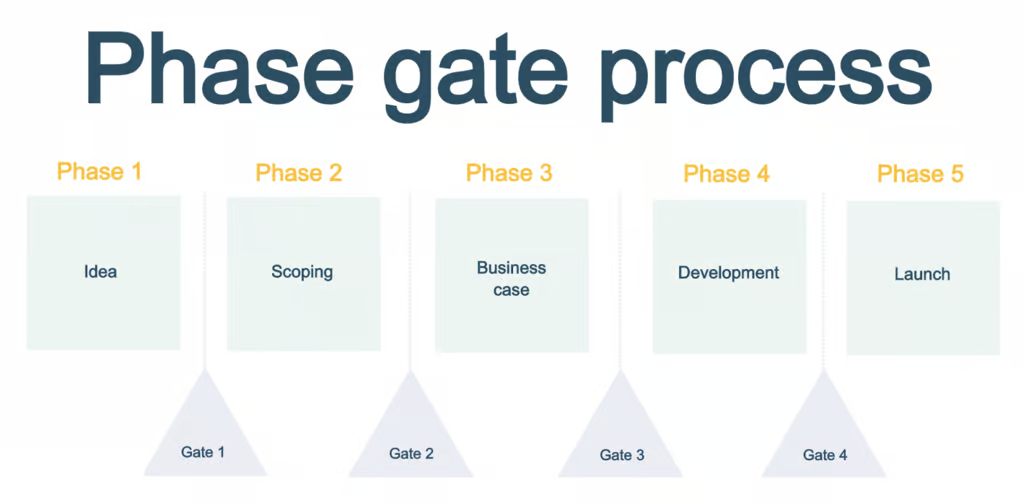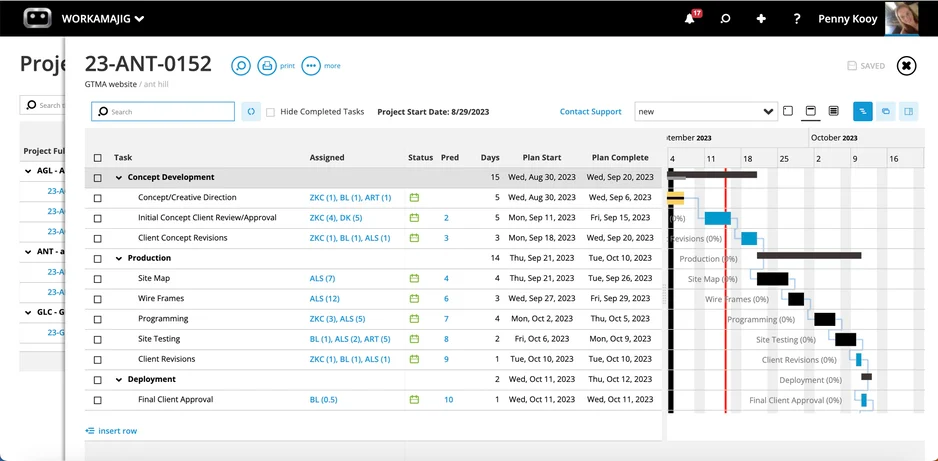What is the Phase Gate Process?
The phase gate process is a project management methodology by which a project must ‘clear the gate’ at various project stages to be approved for continuation. The project must meet certain criteria before proceeding to the next gate.
The phase gate process is similar to the waterfall methodology in that it is linear, and one task cannot be completed before the previous one has been completed.
The phase gate process is particularly beneficial to larger corporations, where there are many moving parts, and is generally used for new product development.

Credit: Pixababy
What are the 5 phases in the phase gate process?
- Idea: Every project begins with a conceptual idea. Often, ideas are based on market trends or gaps in the market. To help you develop viable ideas, seek insight from customers (or prospective customers). Business owners are often amazed to find out that customers have quite a different idea about their product than they thought!
- Scoping: The purpose of this stage is two-fold. The first step is the SWOT analysis, in which you determine your idea’s strengths, weaknesses, opportunities, and threats. This helps you with the second stage, fleshing out the project scope, which, in turn, enables you to figure out whether or not the project is feasible.
- Business Case: In this phase, you build a business case to justify the project. To do this, you’ll need to make a plan and determine risks and likelihood of success. Based on that, you can see how feasible the project is.
- Product Development: Also known as the prototyping phase, the development phase is when you design your product and come out with a prototype.
- Launch: You can have an amazing product, but at this point, you need to market it if you want people to know about it and ultimately buy it.

Credit: Wrike
What is the phase gate review process?
As depicted in the image above, between every phase, there is a gate. What qualifies a phase to go through to the next gate?
Three criteria:
- Quality of Execution: Does the work produced until now meet quality expectations, i.e. is it to a high enough standard?
- Business Rationale: Does this project still make sense business-wise?
- Action Plan: Even if the above two criteria are met, do you have the capacity to keep the project going? For example, do you have enough resources?
Based on the above, the project team chooses from the following options:
- Go: Move forward with the project.
- Kill: End the project because one, some, or all of the above criteria were lacking.
- Hold: Shelve the project for now with the intention of revisiting it in the future. The project still has potential, but it doesn’t make sense to prioritize it over other projects at the moment.
- Recycle: The project can move forward on condition that necessary changes are made.
At this point, you’re probably wondering how exactly a team decides to proceed, kill, hold, or recycle the project.
The answer is to use gating items. Gating items are specific criteria that a project must meet in order to move on to the next phase. The team decides on gating items in advance. There are two types of gating items: criteria that a project must meet and criteria that a project should meet.
If a project phase fails to meet a ‘must meet’ gating item, the project is killed. If a project phase fails to meet a ‘should meet’ gating item, then it depends; every ‘should meet’ gating item has a score and the scores of all the should meets are added to decide whether the project should go, kill, hold, or recycle.
What are the advantages of the phase gate process?
- Prioritizes Efficiency: The truth is that it’s hard to be objective and stop a project once you’ve invested time and effort into it. However, letting a project run its course just for the sake of it is not a wise business move. Using the phase gate process helps you prioritize project efficiency over all else, empowering companies to make calculated decisions at every project stage.
- Greatly increases the likelihood of success: Following on from the above point, the phase gate process makes it a lot more likely that your projects will succeed as there are checkpoints throughout the project to ensure that things are going right.
- Good for large companies: When there are many people and moving parts involved, the phase gate process can be a real savior. It prevents confusion from many different opinions, as there are specific criteria for a project to pass. Additionally, when many employees are involved, it keeps everyone on task.
- Problems are detected quickly: Risks are greatly minimized as problems are nipped in the bud.
- Fast project completion rate: There isn’t much room for projects to drift off task when you are using the phase gate process. The phases and gates help employees stay on task and work efficiently.
What are the challenges of the phase gate process?
- Before embarking on the phase-gate process, check that it is compatible with the project management tools you currently use. If you have a project management tool that uses specific processes, you may not be able to integrate the phase gate process so easily. However, many PM tools do have the capacity to incorporate the phase-gate process, like those with milestone tracking.
- The phase gate process doesn’t leave much room for flexibility as gate criteria are predefined. It can also lead to a project team following instructions blindly instead of using their creativity to work through challenges.
What are some phase gate process best practices?
- Get the right people involved: Since the phase gate process involves a lot of decision-making, it’s important to assign the right stakeholders to the task of making the go/kill/hold/recycle decisions. They need to be people who are involved enough in the project and have enough experience to make wise decisions.
- Determine criteria early on: You don’t want to reach a gate only to realize that you don’t know what decisions need to be made. Determine gate criteria before the project begins to make swift and objective decisions.
- Create a collaborative environment: To make the best project decisions, you need an environment where employees are comfortable and encouraged to voice their opinions. You’ll need input from all relevant team members to make the best decisions at each gate.
- Direction from senior management: At the end of the day, there needs to be someone to approve final decisions; otherwise, you can end up with ‘whoever shouts the loudest wins’ scenarios. You also need senior management to direct meetings at every gate.
How can Workamajig help you with the phase-gate process?
If you want to make real progress and see real results from the phase-gate process, my best advice to you at the end of the day is to get yourself the right tools.
With Workamajig at your side, the phase gate process becomes a hop, skip, and jump.
We equip you with:
- Communication tools so you can quickly and easily make decisions at each gate
- Real-time project updates so that you know how well your project is doing at a glance
- Project management tools so the likelihood of projects succeeding through each gate skyrockets
- Milestone tracking so that you can just plug your data in and Workamajig will give you the answers you need to determine a project’s worth.

Workamajig is what success looks like
Find out more here


